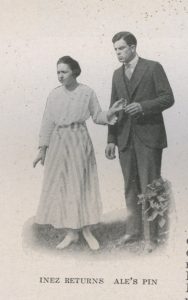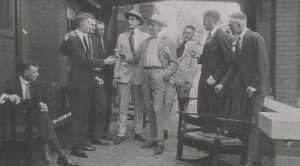Betty Gibson, a University of Illinois freshman, is attracted to a wealthy classmate named Eduardo Salazar. Between registering for classes, attending parties at fraternity houses, watching baseball games, and conducting experiments in the chemistry laboratory, Betty realizes her true love is actually fellow student Happy Harding and the two become engaged. Meanwhile, Dale tries to win back the affections of Inez after she returns his pin. This is the plot of Pro Patria a movie filmed at the University of Illinois in the summer of 1916.[1]
Advertised as “the first all-University movie ever attempted,” virtually ever aspect of the film was connected to campus. The writer, director, and star of the film was student Vivian Kay and it was produced by alumni. [2] The rest of the cast consisted of members of the Illini Photoplayers student organization and other dramatic societies on campus. Special cameo appearances were made by Dean of Men Thomas Arkle Clark and his wife Alice, Athletic Director George Huff, and Coach Bob Zuppke. [3] Even University President Edmund James appeared on horseback in the film. [4] Scenes were filmed all over campus including the Boneyard Creek, Illinois Field, and the Sigma Chi and Alpha Tau Omega fraternity houses. Chicago filmmaker R.E. Norman, who would go on to direct many important silent films including The Flying Ace, served as the cameraman for the production.
The film aimed to provide an authentic depiction of student life in 1916 showing scenes of registration day, sorority pledge day, athletic events, and students working in the chemistry laboratory. The finished production was shown on campus and at the local Park Theatre (now the Art Theatre). The Alumni Association also rented the reels out to regional alumni groups nationwide for screenings (and encouraged the singing of Illinois songs between acts). [5]
Pro Patria received mixed reviews. “The movie is beyond expectation,” the Daily Illini declared in their review. “Every picture and every close-up is extremely clear due to the excellent work of Mr. R.E. Norman who photographed the production. Scenic effects are equally good each having been arranged that one would scarcely recognize some of the old familiar places about the campus. Even the muddy old Boneyard is transformed into a clear running stream.” The review went on to praise the actors as seeming “to live the part” and calling the plot “intensely interesting.” [6]
Alumni, however, had a very different reception of the film. They described the acting as “minor student mimicry which is admittedly melodramatic” and the plot as “surely about the silliest and mushiest accumulation of piffle.” Some viewers took issue with how small a role academics appeared to play in the film’s depiction of a student’s life at the University of Illinois. “High school students seeing it might get the idea that Illinois is a fussers’ paradise and that books are not found anywhere but the library.” One particularly critical alumnus asked, “Hasn’t the University some good friend who will take this film out into the woods some dark night and touch a match to it?” [7]
These few reviews and images from the Illio yearbook are all that remain of Pro Patria today as the actual film appears to have been lost to history.
[1] “Student Life is Shown in Movie,” Daily Illini, September 21, 1916.
[2] “Campus Moving Picture Shown Again at Lecture,” Daily Illini, March 7, 1918.
[3] “Illinois in Movieland,” The Alumni Quarterly and Fortnightly Notes, October 1916.
[4] “Stop the Movie?” The Alumni Quarterly and Fortnightly Notes, November 1916.
[5] “Illinois in Movieland,” The Alumni Quarterly and Fortnightly Notes, October 1916.
[6] “Critic Delighted with Pro Patria” Daily Illini, August 5, 1916.
[7] “Stop the Movie?” The Alumni Quarterly and Fortnightly Notes, November 1916.



